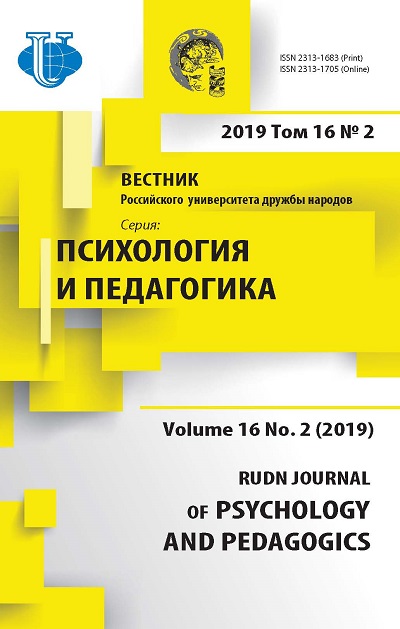90-летие Psi Chi: Международное психологическое общество почета
- Авторы: Такушьян Г.1
-
Учреждения:
- Университет Фордхэм
- Выпуск: Том 16, № 2 (2019)
- Страницы: 224-236
- Раздел: МЕЖДУНАРОДНОЕ НАУЧНОЕ СОТРУДНИЧЕСТВО: К 10-ЛЕТИЮ ИНТЕРНАЦИОНАЛИЗАЦИИ PSI CHI
- URL: https://journals.rudn.ru/psychology-pedagogics/article/view/21376
- DOI: https://doi.org/10.22363/2313-1683-2019-16-2-224-236
Цитировать
Полный текст
Аннотация
В 2019 году Psi Chi празднует свое 90-летие как Национальное и 10-летие как Международное психологическое общество почета. Представленный обзор славной истории Psi Chi состоит из трех частей, описывающих: 1) текущую миссию, объединяющую более 750 000 пожизненных членов в 1130 отделениях по всему миру; 2) скромное, но вдохновляющее рождение в 1929 году в Йельском университете; 3) четыре вехи впечатляющей смелости в истории Psi Chi - в 1929, 1959, 1981 и 2009 годах; а также включает библиографию, с помощью которой можно подробнее познакомиться с историей Psi Chi.
Об авторах
Гарольд Такушьян
Университет Фордхэм
Автор, ответственный за переписку.
Email: takoosh@aol.com
Ph.D., профессор психологии, урбанистики и организационного лидерства в Университете Фордхэм (США, Нью-Йорк). Был президентом отделения международной психологии Американской психологической ассоциации (2003 г.), а также офицером и президентом Psi Chi (199-2000 гг.). Избран заслуженным членом Psi Beta и Psi Chi. Как и тысячи других, он глубоко благодарен Psi Chi за сильное влияние на его жизнь
Соединенные Штаты Америки, 10023, Нью-Йорк, 113 W. 60th StСписок литературы
- Cousins, R.H., Tracy, C., & Giordano, P.J. (1992). Psi Chi and Psi Beta: The two national honor societies in psychology. In A.E. Puente, J.R. Matthews, & C.L. Brewer (Eds.), Teaching psychology in America: A history (pp. 403-427). Washington DC: American Psychological Association.
- Davis, S.F., & Wertheimer, M. (Eds.). (2000). An oral history of Psi Chi, the National Honor Society in Psychology. Chattanooga TN: Psi Chi.
- Hogan, J.D., & Sexton, V.S. (1993). Psi Chi, the National Honor Society in Psychology. In J.L. Pate & M. Wertheimer (Eds.), No small part: A history of regional organizations in American psychology (pp. 189-203). Washington DC: American Psychological Association.
- Hogan, J.D., & Takooshian, H. (2004, Spring). Psi Chi, the National Honor Society in Psychology: 75 years of scholarship and service. Eye on Psi Chi, 8, 16-39. Retrieved from: www.psichi.org/ page/083EyeSpringaHogan#.XM5mWTBKjbi
- Hunt, T. (Ed.). (1979). History of Psi Chi: Fiftieth anniversary. Washington DC: Psi Chi.
- Karlin, N.J. (1998). Psi Chi: encouraging excellence in psychology. Chattanooga TN: Psi Chi [9-minute video]. Retrieved from: http://youtu.be/gIKMZdNgumE
- MacKinney, A.C. (Ed.). (1986). History of Psi Chi, the National Honor Society in Psychology: 1929-1986. Arlington VA: Psi Chi.
- Takooshian, H., & Newman, S.E. (1998). Recognizing excellent psychology students. International Journal of Psychology, 33, 367-369. Retrieved from: https://doi.org/10.1080/002075998400268
- Tracy, C. (2000). Psi Beta. In A.E. Kazdin (Ed.), Encyclopedia of Psychology. (Vol. 6, pp. 332-333).
- Washington DC: American Psychological Association.
- Bockert, D.P. (2008, Fall). Special issue in honor of Kay Wilson. Eye on Psi Chi, 8(1), 1-56.
- Carmody, D.P. (1998, Spring). Student views on the value of undergraduate presentations. Eye on Psi Chi, 2, 11-14. Retrieved from: http://www.kon.org/stud_views.html
- Davis, J.M. (in press). Psi Chi Goes International. RUDN Journal of Psychology and Pedagogics.
- Heitner, E. & Denmark, F.L. (2000, Spring). The impact of Psi Chi on eminent psychologists. Eye on Psi Chi, 4(3), 14-16.
- Hogan, J.D. (2001, Winter). The “other” founders of Psi Chi. Eye on Psi Chi, 5(2), 9-11.
- Hogan, J.D. (2009). Ruth Hubbard Cousins (1920-2007). American Psychologist, 64(1), 48.
- Lewis, F.H. (1969, Fall). Message from the first historian of Psi Chi. Psi Chi Newsletter, p. 7.
- McCormick M.A., Takooshian H., Denmark F.L., del Pilar Grazioso M., Velayo R.S., Wang, A.Y., Zlokovich M.S. (2014). Building Bridges: Psi Chi and International Psychology. RUDN Journal of Psychology and Pedagogics, (4), 5-16. http://dx.doi.org/10.22363/2313-1683-2014-4-5-16
- Novikova, I.A., Tarkhova, V.S., Kardashova, S.Z., & Kharitonenko, A.A. (2019). RUDN Journal of Psychology and Pedagogics, 16(1), 101-109. http://dx.doi.org/10.22363/2313-1683-2019-16-1-88-100
- O’Roark, A.M. (2018). Footprints and visions: 75 years of the International Council of Psychologists. New York: Global Scholarly Publications.
- Takooshian, H. (1994, August). Psi Chi: The impact of a student honor society on a nation’s psychology. Presentation to the International Council of Psychologists, Lisbon, Portugal.
- Takooshian, H. (1998, Fall). Presidential message #1: Seventy years young. Eye on Psi Chi, 3(1), 55-56.
- Takooshian, H. (1999, Spring). Presidential message #3: What is your Psi-Q? Eye on Psi Chi, 3(3), 67-68. Retrieved from: www.psichi.org/general/custom.asp?page=033EyeSpr99hTakooshi#. XM3S6zBKjbg
- Takooshian, H. (2013, Fall). Psi Chi International Ambassadors, 2013. International Psychology Bulletin, 17(4), 13-14.
- Takooshian, H., & Bais, A.M.S. (2017, Winter). A pre-history of the APA Division of International Psychology. International Psychology Bulletin, 21(1), 11-13.
- Takooshian, H. & Salovey, P. (2004, Nov.). Psign of the times. APS Observer, 17(11), 23-24. Retrieved from: https://www.psychologicalscience.org/observer/psign-of-the-times
- Takooshian, H., Velayo, R.S. & Prohaska, V. (2002, Spring). Funding undergraduate research. Eye on Psi Chi, 6, 34-35.
- Van Rossen, E., McCaslin, S., Owusu-Banahene, N.O., & Wiking, M.G. (2003, Winter). The International Psychology Students’ Organization (IPSO). Eye on Psi Chi, 7(2), 26-27. Retrieved from: www.psichi.org/page/072EYEWin03eRossen#.XL0sFzBKjbg
- Wang, A.Y. (2010, Fall). Report to Psi Chi members. Eye on Psi Chi, 15(1), 6.
- Wilson, K., & Bockert, D.P. (1991). Ruth H. Cousins Commemorative Issue. Psi Chi Newsletter, 17(5), 1-60.
- Young, J.R., & DaPrada, T. (1998, Spring). Twenty-five years of the Hunter Psychology Convention. Eye on Psi Chi, 2(3), 15-17.
- Zlokovich, M.S. (2010, October 14). Strategic plan for international expansion. Unpublished report.
- Zlokovich, M.S. (2012, Fall) Psi Chi and international psychology. Eye on Psi Chi, 17(1), 6. Retrieved from: www.psichi.org/general/custom.asp?page=international_histor#.XOsDBhZKjbg
- Zoma, M., & Gielen, U. P. (2015). How many psychologists are there in the world? International Psychology Bulletin, 19, 47-50.















